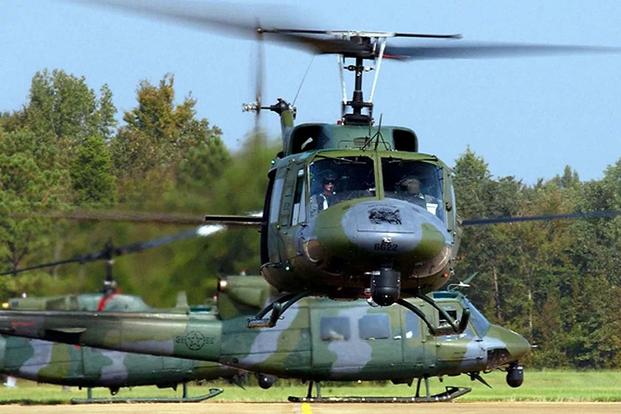The U.S. Air Force has picked Boeing Co. to build the replacement for its UH-1N Huey helicopter at a cost of approximately $2.38 billion, the service announced Monday.
The award stipulates approximately $375 million for the first four MH-139 helicopters, manufactured in partnership with Leonardo-Finmeccanica, and includes equipment integration.
The firm-fixed-price contract will save taxpayers roughly $1 billion, the Air Force's top civilian said.
"Strong competition drove down costs for the program, resulting in $1.7 billion in savings to the taxpayer," Air Force Secretary Heather Wilson said in a statement.
The program provides "for the acquisition and sustainment of up to 84 MH-139 helicopters," as well as training, maintenance and support equipment, the Defense Department said in a release.
Related content:
- STRATCOM Chief Will 'Die Trying or Kill Somebody' to Get New Helo
- Lawmaker Bashes Delay on Huey Replacement Program
- Budget Bill Dramatically Boosts Funding for Huey Replacement Program
The first operational helicopters are expected to be delivered in fiscal 2021, according to the Air Force.
"A safe, secure and effective nuclear enterprise is job one," Air Force Chief of Staff Gen. David Goldfein said Monday. "It is imperative that we field a capable and effective helicopter to replace UH-1Ns, providing security for our ICBMs and nuclear deterrence operations."
Boeing beat out the Lockheed Martin-owned Sikorsky, which pitched a modified HH-60U for the replacement, and Sierra Nevada Corp., which offered an upgraded Army UH-60L.
"We're grateful for the Air Force's confidence in our MH-139 team," said David Koopersmith, vice president and general manager of Boeing Vertical Lift, in a release. "The MH-139 exceeds mission requirements. It's also ideal for VIP transport, and it offers the Air Force up to $1 billion in acquisition and lifecycle cost savings."
The helicopters will be manufactured in Pennsylvania.
"With the [Leonardo] AW139 platform's more than 2 million flight hours and established supply chain, we look forward to applying our expertise to drive cost savings while supporting mission readiness," added Ed Dolanski, president of U.S. Government Services at Boeing Global Services.
Last month, the head of U.S. Strategic Command, which uses the aging Huey helicopter for aerial protection of its missile sites, said a new helicopter is not only a necessity but long overdue.
"We are going to get a new helicopter in the missile fields," Gen. John Hyten said Aug. 1 during his opening remarks at the 2018 STRATCOM Deterrence Symposium in Omaha, Nebraska.
"We are going to get a new helicopter if I have to die trying or if I have to kill somebody to do it."
The replacement program has been in the works for more than a decade.
"It is taking way too long," Hyten said during his speech.
The service moved forward with the Huey replacement effort in April 2017 when it released a new draft request for proposal to "continue dialogue with industry to ensure final RFP release this summer and contract award in FY18," officials said at the time.
As part of the $1 trillion 2017 omnibus spending bill, lawmakers allotted $75 million toward the program, bumping the two-year budget total to $93.3 million, according to budget documents. The 2016 request asked for only $18 million.
The process was soon tied up in a pre-award protest, however, when Sikorsky, a subsidiary of Lockheed Martin Corp., filed a pre-emptive opposition in February involving technical data rights, which it would have to turn over to the Defense Department if the company's helicopter, the HH-60U, won the competition, according to a Defense News report. The Government Accountability Office dismissed Lockheed's suit in May.
The UH-1Ns -- some of which entered the Air Force's inventory in 1970 -- will continue to support five commands and numerous missions, including operational support airlift, test support, and Intercontinental Ballistic Missile security support until the replacements are ready.
The announcement marks the second major contract award for Boeing in recent weeks. The U.S. Navy earlier this month selected the U.S.'s largest aerospace firm to build its first operational carrier-based MQ-25 tanker drone.
-- Oriana Pawlyk can be reached at oriana.pawlyk@military.com. Follow her on Twitter at @Oriana0214.










